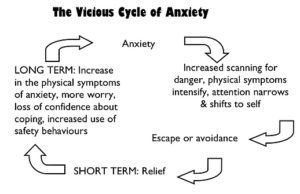By: Laura Miller, LMSW
There’s no question that 2020 has been a year of significant and unrelenting challenges. Across the globe, individuals have been tasked with managing financial crises, flexibly adapting to virtual learning and or employment, monitoring and coping with on-going health risks and tragically, over 280,000 families are grieving the loss of loved one due to COVID-19. In addition to these challenges, one of the most difficult things of 2020, has been the invisible yet fiercely felt unprecedented levels of uncertainty that we are confronted with daily. Humans find comfort in routine, yet 2020 has been a year of ongoing disruption. For many, this may have contributed to a significant decline in overall well-being and mental health. More than one in three adults in the U.S. have reported symptoms of anxiety during the pandemic which is more than triple the number of adults that reported symptoms prior to the pandemic’s start. Continue reading to better understand anxiety as well as learn ways to cope.
What is Anxiety?
Anxiety is the body’s natural response to stress. It is a feeling of fear or apprehension about what’s to come or at times, preoccupation and worry about something that has already occurred. Although anxiety can be uncomfortable, anxiety is actually a very normal and helpful emotion. Anxiety helps individuals respond to real danger (i.e. prompts you to move quickly out of the way of a speeding car) as well as prompts individuals to perform at their best (i.e. motivates you to prepare for a test/job presentation).
What Happens?
When anxiety is experienced, the body’s “fight-flight-freeze” response is triggered, which helps the body prepare to defend itself. This is a very helpful response when someone is in danger; for example, when a bear is coming at you while hiking in the woods! In this dangerous moment, anxiety will help you “fight” (i.e. yell and wave your arms to appear big and scary to the bear), flee (i.e. sprint away from the bear to safety) or freeze (stay quiet and still until the bear passes).
 However,“fight-flight-freeze” can also be triggered in non-threatening moments. Emotions are blind to what is actually happening, resulting in this response being triggered when something feels dangerous but really isn’t, such as beginning your first day of work or school entirely remotely or thinking about when you will be able to gather with a large group of friends. Although these moments are certainly challenging, they are not dangerous per-se. Yet, the feeling of danger can be so strong that you may snap at people (fight), have a hard time thinking clearly (freeze) or become overwhelmed enough that you entirely avoid your work or school responsibilities (flight). Anxiety becomes a problem when our “fight-flight-freeze” response continues to react when there is no danger present. It’s similar to having an overly sensitive smoke alarm system in your body; you certainly want to make sure it’s functioning properly for when there is danger present, but don’t want it alerting you to false alarms.
However,“fight-flight-freeze” can also be triggered in non-threatening moments. Emotions are blind to what is actually happening, resulting in this response being triggered when something feels dangerous but really isn’t, such as beginning your first day of work or school entirely remotely or thinking about when you will be able to gather with a large group of friends. Although these moments are certainly challenging, they are not dangerous per-se. Yet, the feeling of danger can be so strong that you may snap at people (fight), have a hard time thinking clearly (freeze) or become overwhelmed enough that you entirely avoid your work or school responsibilities (flight). Anxiety becomes a problem when our “fight-flight-freeze” response continues to react when there is no danger present. It’s similar to having an overly sensitive smoke alarm system in your body; you certainly want to make sure it’s functioning properly for when there is danger present, but don’t want it alerting you to false alarms.
How to Cope:
Differentiate between “real” and “false” alarms. Check the facts of the situation, is there real danger present? Is there a threat to your life or health or a threat to someone that you care about? If not, begin to wonder if this may be a “false alarm.” Try describing the facts of the situation that you can observe through your five senses and challenge any judgments that might come up. Ask yourself, “Am I assuming a threat to come true?”. If so, label the threat, and assess the probability of your assumption coming true. Try to think of as many other possible outcomes as you can. You can even imagine yourself coping well with “worst case scneario” too!
Get to Know Your Anxiety. Learning the warning signs of anxiety can help you become less afraid of it when it occurs. (Oftentimes we experience anxiety, about our anxiety!) Get to know your anxiety by noticing what happens when you're anxious. You can ask yourself; “What happens when I’m anxious?” or “Where do I feel anxiety in my body?”. Many people experience physical sensations such as an increased heart beat, sweating, stomach upset, feeling dizzy or numbness. Also be on the lookout for anxious thoughts. Are you only thinking about worst case scenarios and “what ifs”? Label these thoughts as “anxiety mind” and indicators of a “false alarm.” Then, try to replace your anxious thoughts with positive coping statements like; “this may be hard and I can ask for help if I need it.”
Don’t Avoid Situations That Make You Anxious (Yes, really!!). It’s entirely natural to want to avoid the situations that make you anxious. However, if you continue to avoid situations that are non-threatening, you and your brain will never get the opportunity to learn that 1) your feared worst case scenario might not have actually come true and 2) you might actually have been able to cope even if your feared outcome did occur! Avoidance actually contributes to anxiety increasing creating a vicious cycle. In order to break the cycle, practice “opposite action” and approach the situations that make you anxious!
Practice Relaxation Techniques.
 As discussed, anxiety can prompt physical sensations and physiological arousal that is uncomfortable. In order to combat these changes, practice relaxation techniques. Check out this list of relaxation techniques to try when anxious. Additionally, develop a kit of items that you can use to self-soothe when anxious; perhaps a good smelling candle or favorite blanket to cuddle with!
As discussed, anxiety can prompt physical sensations and physiological arousal that is uncomfortable. In order to combat these changes, practice relaxation techniques. Check out this list of relaxation techniques to try when anxious. Additionally, develop a kit of items that you can use to self-soothe when anxious; perhaps a good smelling candle or favorite blanket to cuddle with!


